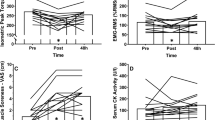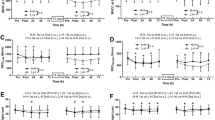Abstract
Here, we test the hypothesis that continuous concentric exercise training renders skeletal muscles more susceptible to damage in response to eccentric exercise. Elite road cyclists (CYC; n = 10, training experience 8.1 ± 2.0 years, age 22.9 ± 3.7 years), long-distance runners (LDR; n = 10, 9.9 ± 2.3 years, 24.4 ± 2.5 years), and healthy untrained (UT) men (n = 10; 22.4 ± 1.7 years) performed 100 submaximal eccentric contractions at constant angular velocity of 60° s−1. Concentric isokinetic peak torque, isometric maximal voluntary contraction (MVC), and electrically induced knee extension torque were measured at baseline and immediately and 48 h after an eccentric exercise bout. Muscle soreness was assessed and plasma creatine kinase (CK) activity was measured at baseline and 48 h after exercise. Voluntary and electrically stimulated knee extension torque reduction were significantly greater (p < 0.05) in UT than in LDR and CYC. Immediately and 48 h after exercise, MVC decreased by 32 % and 20 % in UT, 20 % and 5 % in LDR, and 25 % and 6 % in CYC. Electrically induced 20 Hz torque decreased at the same times by 61 and 29 % in UT, 40 and 17 % in LDR, and 26 and 14 % in CYC. Muscle soreness and plasma CK activity 48 h after exercise did not differ significantly between athletes and UT subjects. In conclusion, even though elite endurance athletes are more resistant to eccentric exercise-induced muscle damage than are UT people, stretch–shortening exercise-trained LDR have no advantage over concentrically trained CYC.




Similar content being viewed by others
Abbreviations
- Ca2+ :
-
Calcium ions
- CK:
-
Plasma creatine kinase activity
- CYC:
-
Road cyclists
- IT:
-
Concentric isokinetic peak torque
- LDR:
-
Long-distance runners
- LFF:
-
Low-frequency fatigue
- MVC:
-
Maximal voluntary contraction
- P100:
-
100 Hz electrically induced torque
- P20:
-
20 Hz electrically induced torque
- SR:
-
Sarcoplasmic reticulum
- UT:
-
Untrained subjects
References
Allen DG, Lamb GD, Westerblad H (2008) Skeletal muscle fatigue: cellular mechanisms. Physiol Rev 88:287–332
Bigland-Ritchie BR, Dawson NJ, Johansson RS, Lippold OC (1986) Reflex origin for the slowing of motoneurone firing rates in fatigue of human voluntary contractions. J Physiol 379:451–459
Bottinelli R, Westerblad H (2011) Reactive oxygen and nitrogen species in skeletal muscle: acute and long-term effects. J Physiol 589(Pt 9):2117–2118
Byrne C, Eston RG, Edwards RH (2001) Characteristics of isometric and dynamic strength loss following eccentric exercise-induced muscle damage. Scand J Med Sci Sports 11(3):134–140
Clarkson PM, Hubal MJ (2002) Exercise-induced muscle damage in humans. Am J Phys Med Rehabil 81:52–69
Close GL, Ashton T, Cable T, Doran D, MacLaren DP (2004) Eccentric exercise, isokinetic muscle torque and delayed onset muscle soreness: the role of reactive oxygen species. Eur J Appl Physiol 91(5–6):615–621
Duchateau J, Balestra C, Carpentier A, Hainaut KJ (2002) Reflex regulation during sustained and intermittent submaximal contractions in humans. J Physiol 15:959–967
Enoka RM, Duchateau J (2008) Muscle fatigue: what, why and how it influences muscle function. J Physiol 586(1):11–23
Evans WJ, Meredith CN, Cannon JG, Dinarello CA, Frontera WR, Hughes VA, Jones BH, Knuttgen HG (1986) Metabolic changes following eccentric exercise in trained and untrained men. J Appl Physiol 61:1864–1868
Flann KL, LaStayo PC, McClain DA, Hazel M, Lindstedt SL (2011) Muscle damage and muscle remodeling: no pain, no gain? J Exp Biol 15:674–679
Friden J, Lieber RL (2001) Eccentric exercise-induced injuries to contractile and cytoskeletal muscle fibre components. Acta Physiol Scand 171:321–326
Gibala MJ, MacDougall JD, Tarnopolsky MA, Stauber WT, Elorriaga A (1995) Changes in human skeletal muscle ultrastructure and force production after acute resistance exercise. J Appl Physiol 78:702–708
Gibson ASC, Lambert MI, Noakes TD (2004) Age-related decrements in cycling and running performance. S Afr J Sports Med 2:8–11
Gleeson N, Eston R, Marginson V, McHugh M (2003) Effects of prior concentric training on eccentric exercise induced muscle damage. Br J Sports Med 37:119–125
Howald H, Hoopeler H, Claassen M, Mathieu O, Straub R (1985) Influences of endurance training on the ultrastructural composition of the different muscle fibre types in humans. Pflügers Arch 403:369–376
Jackson MJ, McArdle A (2011) Age-related changes in skeletal muscle reactive oxygen species generation and adaptive responses to reactive oxygen species. J Physiol 589(Pt 9):2139–2145
Jones DA (1996) High-and low-frequency fatigue revisited. Acta Physiol Scand 156(3):265–270
Kamandulis S, Skurvydas A, Brazaitis M, Skikas L, Duchateau J (2010) The repeated bout effect of eccentric exercise is not associated with changes in voluntary activation. Eur J Appl Physiol 108(6):1065–1074
Kamandulis S, Skurvydas A, Snieckus A, Masiulis N, Aagaard P, Dargeviciute G, Brazaitis M (2011) Monitoring markers of muscle damage during a 3 week periodized drop-jump exercise programme. J Sports Sci 29:253–345
Kuipers H, Janssen GM, Bosman F, Frederik PM, Geurten P (1989) Structural and ultrastructural changes in skeletal muscle associated with long-distance training and running. Int J Sports Med 10:156–159
Lieber RL, Fridén J (1999) Mechanisms of muscle injury after eccentric contraction. J Sci Med Sport 2:253–265
Löscher WN, Nordlund MM (2002) Central fatigue and motor cortical excitability during repeated shortening and lengthening actions. Muscle Nerve 25:864–872
Lynn R, Morgan DL (1994) Decline running produces more sarcomeres in rat vastus intermedius muscle fibers than does incline running. J Appl Physiol 77:1439–1444
McArdle A, Vasilaki A, Jackson M (2002) Exercise and skeletal muscle ageing: cellular and molecular mechanisms. Ageing Res Rev 1:79–93
McHugh MP (2003) Recent advances in the understanding of the repeated bout effect: the protective effect against muscle damage from a single bout of eccentric exercise. Scand J Med Sci Sports 13:88–97
McHugh MP, Tetro DT (2003) Changes in relationship between joint angle and torque production associated with repeated bout effect. J Sports Sci 21:927–932
Millet GY, Martin V, Martin A, Vergès S (2011) Electrical stimulation for testing neuromuscular function: from sport to pathology. Eur J Appl Physiol 111:2489–2500
Nosaka K, Clarkson PM (1996) Variability in serum creatine kinase response after eccentric exercise of the elbow flexors. Int J Sports Med 17(2):120–127
Nosaka K, Newton M (2002) Concentric or eccentric training effect on eccentric exercise-induced muscle damage. Med Sci Sports Exerc 34:63–69
Nosaka K, Newton M, Sacco P (2002) Delayed-onset muscle soreness does not reflect the magnitude of eccentric exercise-induced muscle damage. Scand J Med Sci Sports 12(6):337–346
Parikh S, Morgan DL, Gregory JE, Proske U (2004) Low-frequency depression of tension in the cat gastrocnemius muscle after eccentric exercise. J Appl Physiol 97:1195–1202
Ploutz-Snyder LL, Tesch PA, Dudley GA (1998) Increased vulnerability to eccentric exercise-induced dysfunction and muscle injury after concentric training. Arch Phys Med Rehabil 79:58–61
Proske U, Morgan DL (2001) Muscle damage from eccentric exercise: mechanism, mechanical signs, adaptation and clinical applications. J Physiol 537:333–345
Rodríguez LP, López-Rego J, Calbet JA, Valero R, Varela E, Ponce J (2002) Effects of training status on fibers of the musculus vastus lateralis in professional road cyclists. Am J Phys Med Rehabil 81(9):651–660
Skurvydas A, Brazaitis M, Kamandulis S, Sipaviciene S (2010) Peripheral and central fatigue after muscle-damaging exercise is muscle length dependent and inversely related. J Electromyogr Kinesiol 20:655–660
Skurvydas A, Brazaitis M, Kamandulis S (2011a) Repeated bout effect is not correlated with intraindividual variability during muscle-damaging exercise. J Strength Cond Res 25:1004–1009
Skurvydas A, Brazaitis M, Venckūnas T, Kamandulis S (2011b) Predictive value of strength loss as an indicator of muscle damage across multiple drop jumps. Appl Physiol Nutr Metab 36:353–360
Takekura H, Fujinami N, Nishizawa T, Ogasawara H, Kasuga N (2001) Eccentric exercise-induced morphological changes in the membrane systems involved in excitation-contraction coupling in rat skeletal muscle. J Physiol 533:571–583
Thompson HS, Clarkson PM, Scordilis SP (2002) The repeated bout effect and heat shock proteins: intramuscular HSP27 and HSP70 expression following two bouts of eccentric exercise in humans. Acta Physiol Scand 174:47–56
Uchida MC, Nosaka K, Ugrinowitsch C, Yamashita A, Martins E Jr, Moriscot AS, Aoki MS (2009) Effect of bench press exercise intensity on muscle soreness and inflammatory mediators. J Sports Sci 27(5):499–507
Vøllestad NK, Sejersted OM, Bahr R, Woods JJ, Bigland-Ritchie B (1988) Motor drive and metabolic responses during repeated submaximal contractions in humans. J Appl Physiol 64:1421–1427
Warhol MJ, Siegel AJ, Evans WJ, Silverman LM (1985) Skeletal muscle injury and repair in marathon runners after competition. Am J Pathol 118:331–339
Warren G, Lowe DA, Armstrong RB (1999) Measurement tools used in the study of eccentric contraction-induced injury. J Sports Med 27:43–59
Whitehead NP, Allen TJ, Morgan DL, Proske U (1998) Damage to human muscle from eccentric exercise after training with concentric exercise. J Physiol 512:615–620
Yu JG, Malm C, Thornell LE (2002) Eccentric contractions leading to DOMS do not cause loss of desmin nor fibre necrosis in human muscle. Histochem Cell Biol 118:29–34
Conflict of interest
The authors declare that they have no conflict of interest.
Author information
Authors and Affiliations
Corresponding author
Additional information
Communicated by Toshio Moritani.
Rights and permissions
About this article
Cite this article
Snieckus, A., Kamandulis, S., Venckūnas, T. et al. Concentrically trained cyclists are not more susceptible to eccentric exercise-induced muscle damage than are stretch–shortening exercise-trained runners. Eur J Appl Physiol 113, 621–628 (2013). https://doi.org/10.1007/s00421-012-2470-1
Received:
Accepted:
Published:
Issue Date:
DOI: https://doi.org/10.1007/s00421-012-2470-1




